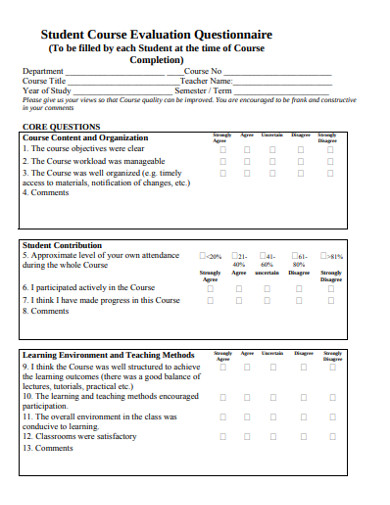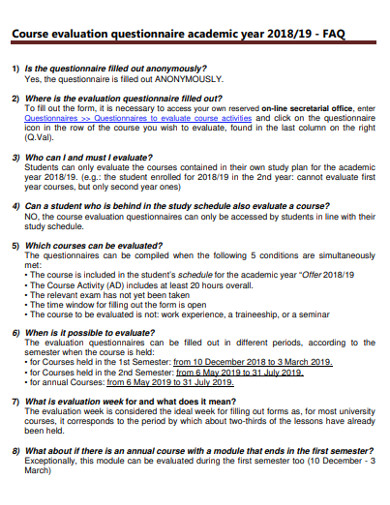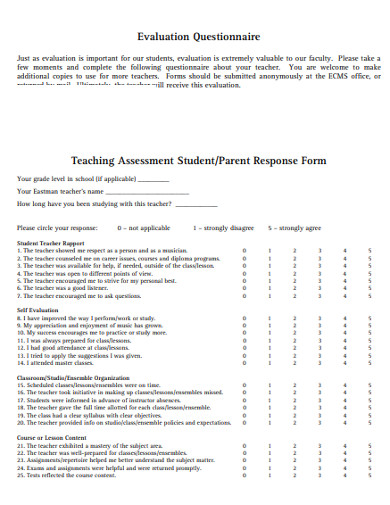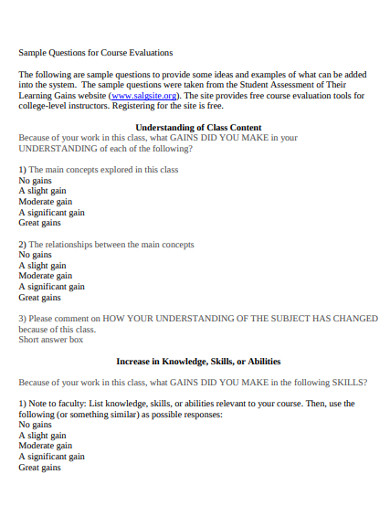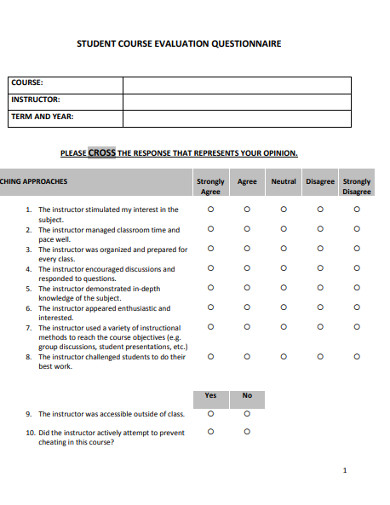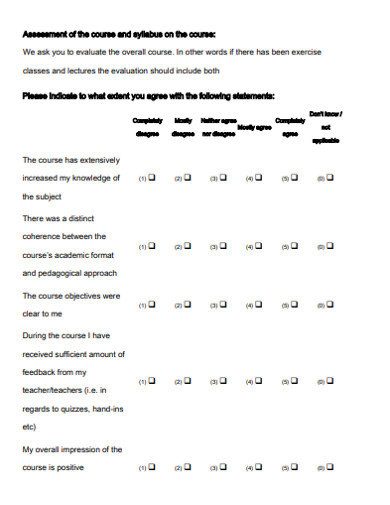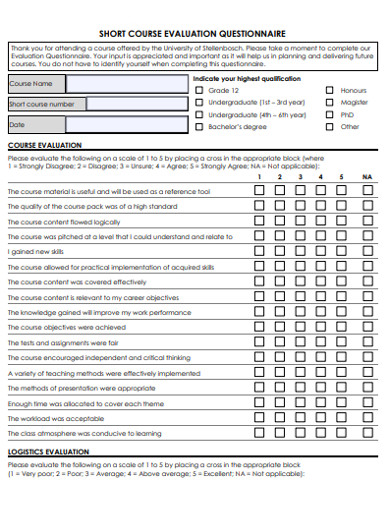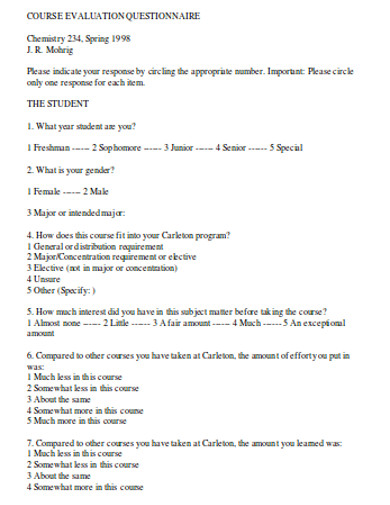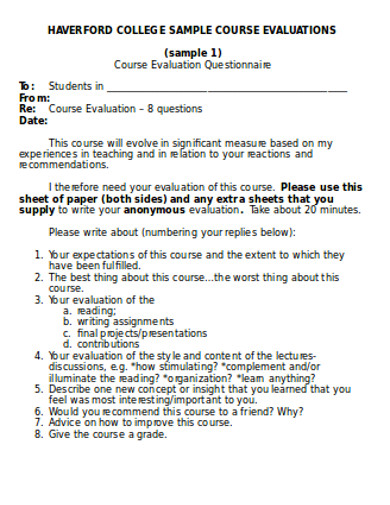10+ Course Evaluation Questionnaire Examples to Download
Academic institutions are no stranger to reforms. They equip students with worldly know-how to make it on their own. Therefore, the capacity of the youth to take society farther than where it is today lies in the capability of the schools to make that happen. Course evaluation allows schools to be responsive to the dynamism of the real world. The constructive reviews help maintain a timely and conducive learning ecosystem for the community.
Course evaluation is a review resource for a course, program, or personnel. In universities, it is administered after the semester or the school year. It acts like a research method that collects data anonymously for analysis. The data is used to evaluate and improve the learning programs and the educator under review.
Pros of Evaluation Questionnaires
Course evaluation questionnaires have a proactive effect that isn’t just isolated in the present conditions. The results are useful for future students and members of the university. The assessment show what courses, school programs, and which instructors are displaying promising growth. It also helps the university see their learning ecosystem in the eyes of the main stakeholders: the students.
To Students
The questionnaires let the students share their experience with the course and the professor. The anonymity afforded by the method gives the students the liberty to express their sentiments and called-for opinion. They can provide input on how they would have wanted their experience in the subject be. They can add their expectations and point out avenues for improvement.
To Educators
When the university realizes the strengths and weaknesses of their system as evaluated by the students who experienced it firsthand, they can build on the positive notes, as well as remedy what doesn’t work. Instructors get to be assessed on their class performance and teaching strategies. They can compare what they saw with what the students saw. Therefore, the review is not one-sided.
Current Evaluation Model
Any organization has finite resources. Therefore, they must distribute each strategically to ensure positive returns. When it invests its resources on programs like new courses and changes in the curricula, the program must produce positive results on the students and the school community. Dr. Donald Kirkpatrick was a university professor who designed the model Kirkpatrick training evaluation with four levels.
Reaction: The value of the program to the students is in their reception. The indices include the students’ engagement, participation, satisfaction, and perception of the program. Questions like how was the presentation, the learning strategies used, and the activities performed are few of what will be answered.
Learning: This level assesses how much the students have learned after the program. This can be answered by comparing their answers to the program’s objectives. Therefore, there should be diagnostic and prognostic tests to check how much they have learned.
Behavior: This measures how much of the program learning were retained by the students. This includes the application of knowledge and skills that they have obtained from the program into their performance.
Results: The results of the program are evaluated and assessed. This can include evaluation of any improvement in the students’ scholastic performance and attitude towards learning.
Cons of Evaluation Questionnaires
One of the major criticisms of course evaluation questionnaires is that it is very much susceptible to implicit biases. Implicit biases are a person’s subconscious preconditioned values and belief system. Our prejudices and stereotypes manifest these biases. Everyone is guilty of these to some extent. This affects professors more than the course because the comments can be downright destructive to a person without specific suggestions and explanations. A student’s sentiment regarding an instructor may be influenced by other factors besides the person’s capacity to teach and mentor. Sometimes, the data obtained from the evaluation questionnaires do little to improve a program or learning strategy in any way.
Another mark against this evaluation method is data availability and variety. Whether test questionnaires are administered manually or online, there will be students that won’t be able provide their input. It could be that the students fail to see the value of the evaluation, so this is dismissed. The data, then, won’t be a good representative of the student body.
10+ Course Evaluation Questionnaire Examples & Templates
The criticisms of the method can be remedied by better enforcement of the system. This means that course evaluation questionnaires are still effective means of reviewing the strengths and weaknesses of the instructors and the school program. The following are course evaluation questionnaire samples used by other institutions.
1. Student Course Evaluation Questionnaire Example
2. Laboratory Course Evaluation Questionnaire Example
3. Academic Course Evaluation Questionnaire Example
4. Course Evaluation Questionnaire Parent Response Form
5. Sample Course Evaluation Questionnaire Example
6. Basic Student Course Evaluation Questionnaire Example
7. School Course Evaluation Questionnaire Example
8. Formal Course Evaluation Questionnaire Example
9. Short Course Evaluation Questionnaire Example
10. Course Evaluation Questionnaire in DOC
11. Sample College Course Evaluation Questionnaire Example
Implementing Course Evaluation
Course and faculty evaluation is necessary in making the learning experience gratifying and fulfilling for everyone in the community. Schools and universities have resorted to using questionnaires for this matter. The criticisms that arised from the method can still be addressed with better approaches in the implementation of the review.
1. Provide Evaluation Value
The deficit in public knowledge of how evaluations are used leads to the dismissal of semester-end reviews of learning programs. Therefore, the schools should see to it that the students are well aware of how their input can drive changes in the university. When they recognize that their role as the major stakeholders of the institution is not limited to going to class and getting their degrees, they will become more proactive in their efforts.
2. Recognize Implicit Biases
We all have biases ingrained in our subconcious. We develop them from our exposure to our family, the community, and the mass media. We have to acknowledge that we have them for us to do anything about it. When we recognize that our preconceive notions are influencing our behavior and decisions, we can correct it. The students have to realize this as well. They should be informed that this is normal for humans and that we can do something about it. We can make the necessary corrections to avoid this.
3. Mercury Course Evaluations
This is a two-part evaluation method that consists of numerical evaluation for the first part and comment section for the second part. It allows students to rate their instructors or the course on the numerical scale then justify their ratings in the comment section. Test administrators have to instruct the students to write examples, suggestions, and constructive reviews in the spaces provided. Informative and specific feedback is better evaluation resource than general statements about the greatness or dullness of a class.
4. Reach Out to the Students
Don’t just be confined to a single way of collecting evaluation data. Consider both paper and online means. Administrators can try using evaluation templates and online survey form generator like Google Forms. That way students both in and out the classroom during evaluation time can submit their input. The school should also remind students about the evaluation period and the value of their responses, so as to gather more data.
Course evaluation results are the voice of the student body. And educational reforms born from these results improve learning programs, the university system, and the school community. It makes the school more capable to educate students and future world-changers. Therefore, schools should seek ways to effectively facilitate their evaluation methods for the good of the institution and the society.



